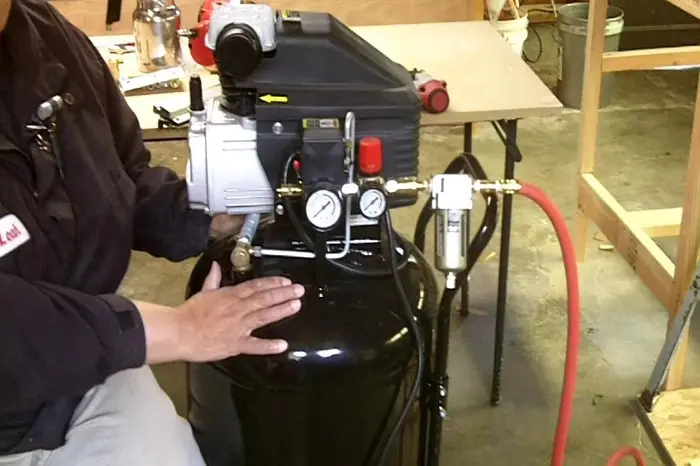Mini air compressors are versatile tools that can simplify various tasks, from inflating tires to powering pneumatic tools. Their compact size and portability make them ideal for home use, outdoor activities, and even professional applications. This article will provide a detailed guide on how to use a mini air compressor effectively, covering everything from setup and operation to maintenance and troubleshooting.
Understanding Mini Air Compressors
What Is a Mini Air Compressor?
A mini air compressor is a smaller, more portable version of traditional air compressors. It typically offers lower pressure and volume but is perfect for light-duty tasks, such as inflating sports equipment, air mattresses, and vehicle tires.
Key Features of Mini Air Compressors
Portability: Lightweight and easy to carry.
Power Source: Can be powered by electricity or batteries.
Pressure Output: Generally ranges from 30 to 150 PSI, depending on the model.
Tank Size: Often tankless, but some models have small tanks for air storage.
Common Applications
Mini air compressors can be used for a variety of tasks, including:
Inflating tires (cars, bicycles, motorcycles)
Blowing up air mattresses or inflatable toys
Powering small pneumatic tools
Cleaning electronics and hard-to-reach areas
Spray painting and applying finishes
Setting Up Your Mini Air Compressor
Unboxing and Inspection
Unpack the Compressor:
Remove the mini air compressor from its packaging.
Ensure all components, including hoses and attachments, are included.
Inspect for Damage:
Check for any visible damage or defects.
Report any issues to the manufacturer or retailer.
Selecting the Right Location
Choose a well-ventilated, dry area to set up your compressor. Ensure there is enough space around the unit for easy access and operation. Avoid placing it near flammable materials or in extreme temperature conditions.
Connecting the Air Compressor
Power Source:
For electric compressors, plug it into a grounded outlet.
For battery-operated models, ensure the battery is fully charged.
Attach the Hose:
Connect the air hose to the compressor’s output port. Ensure it is securely fastened to prevent leaks.
Check for Leaks:
Before use, test the connections for leaks by applying soapy water to the joints. Bubbles indicate a leak that needs to be addressed.
Operating Your Mini Air Compressor
Understanding Controls and Settings
Familiarize yourself with the controls on your mini air compressor, which may include:
Pressure Regulator: Adjusts the output pressure.
On/Off Switch: Turns the compressor on or off.
Pressure Gauge: Displays the current output pressure.
Setting the Desired Pressure
Determine Required PSI:
Check the recommended pressure for the task at hand (e.g., tire inflation, tool operation).
Adjust the Pressure Regulator:
Use the pressure regulator to set the desired PSI before starting the compressor.
Starting the Compressor
Turn on the Power:
Flip the on/off switch to start the compressor.
Monitor the Pressure Gauge:
Watch the pressure gauge as the compressor builds up air pressure to the desired level.
Using the Air Compressor for Specific Tasks
1. Inflating Tires
Connect the Tire Chuck: Attach the tire chuck to the valve stem.
Check the Pressure: Use the pressure gauge to ensure the desired PSI is set.
Inflate: Start the compressor, and let it run until the tire reaches the correct pressure.
Disconnect: Remove the chuck and replace the valve cap.
2. Blowing Up Air Mattresses
Attach the Nozzle: Use the appropriate nozzle for the air mattress.
Inflate: Insert the nozzle into the valve and turn on the compressor.
Monitor Inflation: Check the mattress periodically to avoid over-inflation.
3. Cleaning Electronics
Attach the Blower Nozzle: Connect the blower nozzle to the air hose.
Power On: Start the compressor and direct the air stream towards the electronic components.
Maintain Distance: Keep a safe distance to avoid damaging sensitive components.
4. Powering Pneumatic Tools
Connect the Tool: Attach the pneumatic tool to the air hose.
Check the Pressure: Ensure the compressor is set to the required PSI for the tool.
Use the Tool: Power on the tool and operate it as needed.
Maintenance and Care
Regular Maintenance Tasks
Proper maintenance is essential to prolong the life of your mini air compressor:
Drain Condensation:
If your compressor has a tank, regularly drain moisture to prevent rust and damage.
Check Air Filters:
Inspect and clean or replace air filters as needed to maintain performance.
Inspect Hoses and Connections:
Regularly check hoses and fittings for wear and tear.
Oil Maintenance:
For oil-lubricated models, check and change the oil as per the manufacturer’s instructions.
Troubleshooting Common Issues
Compressor Won’t Start:
Possible Causes: Check the power source and ensure the on/off switch is engaged.
Solution: Inspect the power cord and circuit breaker.
Pressure Fluctuates:
Possible Causes: Leaks in the hose or connections.
Solution: Inspect and tighten connections.
Compressor Overheats:
Possible Causes: Insufficient ventilation or excessive load.
Solution: Allow the compressor to cool down and ensure proper airflow.
No Air Output:
Possible Causes: Blocked air filters or faulty hoses.
Solution: Clean or replace filters and inspect hoses for blockages.
Safety Tips
Wear Protective Gear: Always use safety goggles and gloves when operating the compressor.
Avoid Overloading: Do not exceed the maximum pressure rating for your tasks.
Keep a Safe Distance: Maintain a safe distance from the compressor while it’s running to avoid injuries from high-pressure air.
Store Properly: When not in use, store the compressor in a cool, dry place.
Conclusion
Using a mini air compressor can greatly enhance your efficiency and productivity in various tasks. By understanding how to set up, operate, and maintain your compressor, you can ensure it serves you well for years to come. Whether you’re inflating tires, cleaning, or powering tools, following the guidelines in this comprehensive guide will help you use your mini air compressor effectively and safely.
Related topics:

